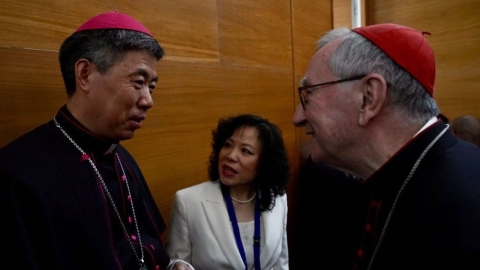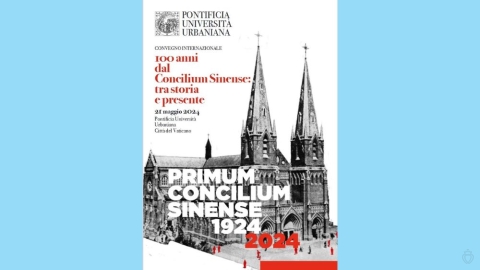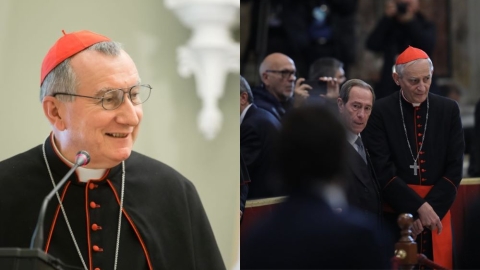The Synod: Chronicle of a Well-Orchestrated Show

In an interview published on the American website BuzzFeed on October 18, 2014, Cardinal Raymond Leo Burke, prefect of the Tribunal of the Apostolic Signature, denounced Francis’ silence during the synod: the pope did “great harm” by not “openly exposing his position” on the subjects that were being so intensely debated. Two days earlier, on October 16, on the website Catholic News Agency, Cardinal Robert Sarah, president of the Pontifical Council Cor Unum, had stated that the intermediary report of October 13 only “partially” reflected the discussions of the Synod Fathers. “Does someone wish to destabilize the Church and undermine her teaching?” he wondered, mentioning his surprise at the publication of a document that still needed to be worked on. And he concluded: “Let us pray for those pastors who abandon the sheep of the Lord to the wolves of a secularized and decadent society, far from God and nature.”
On October 17, Vatican journalist Sandro Magister, on his website chiesa.espressonline, pointed out under the title The True Story of This Synod. The Producer, the Executives, the Assistants, a striking parallel between the maneuvers of the progressivist cardinals during Vatican Council II and those employed during this synod. Here are some long extracts from this clear-sighted analysis; the subtitles were added by DICI:
“(…) Neither the opening towards authorizing civilly remarried divorcees to communicate– and therefore the Church’s acceptance of these re-marriages – nor the impressive change of standards as far as homosexuality is concerned, introduced in the Relatio post disceptationem (Intermediary Report, October 13), would have been possible without a series of moves cleverly calculated by those who were and are in control of the procedures.
“To understand this, it is enough to review the steps that led to this result, even if the synod’s temporary conclusion – as we shall see – did not correspond to what the stage directors expected.
“The principal actor of the first act was Pope Francis himself. On July 28, 2013, during the press conference he gave on the airplane (see DICI#280, Aug. 9, 2013, Brazil: The World Youth Days, July 22-29, 2013 and DICI#282, Oct. 4, 2013, Pope Francis’ Style of Ruling) that brought him back to Rome after his trip to Brazil, he gave two signals that had a very strong and lasting impact on public opinion. The first of the signals concerned the way of behaving towards homosexuals: “If someone is gay and seeks the Lord with good will, who am I to judge him?”
“The second concerned the acceptance of re-marriage [for divorcees]: “A parenthesis: the Orthodox follow the theology of economy, as they call it, and they grant a second possibility [of marriage], they allow it. But I think that this problem – I close the parenthesis – needs to be studied in the context of the pastoral approach to marriage.”
“Next, in October 2013, a synod on the family was called (see DICI#284, Nov. 8, 2013, Preparation of an Extraordinary Synod on the Family). It was to be the first of a series of two synods, spread out over one year, that would work on the same question. As secretary general of this sort of permanent and prolonged synod, the Pope named a brand new cardinal, Lorenzo Baldisseri, who had absolutely no experience on the matter, but who is very close to him. For the occasion, he placed at Baldisseri’s side, as special secretary, bishop and theologian Bruno Forte. The man was already known as one of the principal representatives of the theological and pastoral line of thought whose figurehead was the Jesuit cardinal Carlo Maria Martini (see DICI#284, Nov. 8, 2013, Press Review: Roman Rumblings) and whose great adversaries were first John Paul II, then Benedict XVI: a line of thought whose advocates declared themselves open to a change in the Church’s teachings in the sexual domain.
“The proclamation of the synod was completed with a survey (see DICI#284, Nov. 8, 2013, Preparation for the Extraordinary Synod on the Family), that was sent everywhere in the world, and that contained specific questions on the most controversial subjects, including the distribution of communion to remarried [divorcees] and homosexual unions. Mostly thanks to this survey – whose answers would later be published intentionally by certain German-speaking episcopates (see DICI#290, Feb. 14, 2014, Switzerland and Germany: Answers to the Survey on the Family) – the idea took form in the public opinion that these questions can be considered as already “open” not only in theory, but also in practice.
“We can find an example of this forward flight in the diocese of Freiburg im Breisgau, in Germany, whose archbishop, Robert Zollitsch, was (at the time, ed. note) also president of the German Bishops’ Conference. In a document (see DICI#284, Nov. 8, 2013, Preparation for the Extraordinary Synod on the Family), drawn up by one of its pastoral services, communion for remarried divorcees was encouraged, on the simple basis of a “decision of conscience”.
“From Rome, the prefect of the Congregation for the Doctrine of the Faith, Cardinal Gerhard L. Müller, reacted by republishing in the Osservatore Romano, on October 23, 2013, a note (see DICI#285, Nov. 22, 2013, The Tribunal of the Apostolic Signature, Defender of the Bond of Marriage) that he had written previously and that had been published four months earlier in Germany, in which he confirmed and explained this interdiction to communicate. But this call to the diocese of Freiburg to retract its document had no result. On the contrary, German cardinal Reinhard Marx (see DICI#293, Mar. 14, 2014, Germany: According to Cardinal Marx, Communion for Remarried Divorcees is a Solution Worth Considering), and in more vulgar terms, Honduran Cardinal Óscar Rodríguez Maradiaga (see DICI#291, Feb. 28, 2014, 2013-2014: Motion Accelerates When the End Is Near), criticized Müller, reproaching his “attempt” to put an end to discussions on the matter. Marz and Maradiaga are both members of the council of eight cardinals that Pope Francis asked to help him govern the universal Church. The Pope did not intervene to support Müller.
“On February 20 and 21, 2014, the cardinals gathered in Rome for a consistory. Pope Francis asked them to discuss the family and entrusted the opening speech (see DICI#292, Mar. 14, 2014, Keeping up Confusion on the Situation of the Divorced-and-Remarried) to Cardinal Walter Kasper. This man has since the early 90’s been the belligerent partisan of leaving behind the interdiction to communicate that strikes remarried [divorcees], but he was fought, at the time, by John Paul II and by Joseph Ratzinger. During the consistory, that took place behind closed doors, Kasper completely returned to his former position. Many cardinals opposed him, but Francis gratified him with great praise. Afterwards, Kasper confirmed that he had elaborated his statements “in agreement” with the Pope.
“Kasper also received from the pope, unlike all the other cardinals, the privilege of breaking the silence on what he had said during the consistory. When, on March 1, his speech was published by surprise in the Italian newspaper Il Foglio, the same speech was in fact already being printed by the Queriniana editions. The publication had an enormous echo. In early spring, in order to counterbalance the impact of Kasper’s propositions, the Congregation for the Doctrine of the Faith programmed the publication in the Osservatore Romano of a speech written by a high-profile cardinal and oriented in the opposite direction. But the publication was vetoed by the pope.
“However, Kasper’s proposals underwent severe and argued criticism from a good number of cardinals, who spoke many times in different press organs. On the eve of the synod, five of these cardinals (see DICI#301, Sept. 26, 2014, Cardinal Kasper’s Astounding Response to the Critiques of Five Cardinals and Remaining in the Truth of Christ – Excerpts) re-published in a book their previous speeches, and they mentioned, for additional information, essays that had been written by other researchers and by a high-up director of the Curia, Jesuit, archbishop, and a true connoisseur of the practices of the Oriental Churches with regards to marriage. Kasper, widely approved by the media, lamented the publication of this work, that he presented as an insult aimed at the pope.
“On October 5, the synod opened. Unlike usual, the speeches in the meeting room were not made public (see DICI#302, Oct. 10, 2014, Different Impressions at the Opening of the Synod on the Family). Cardinal Müller protested against this form of censorship. But he obtained nothing. Which is a further proof, he would later say, that “I was not a part of the producing team”. The operational direction of the synod was composed of the secretary general, Baldisseri, and the special secretary, Forte, to whom the pope added those he had personally chosen to write the message and the Relatio at the end of the synod. They all belonged to the pro-change “party” and at their head was the pope’s trusted “ghostwriter”, Víctor Manuel Fernández, archbishop and rector of the Catholic University of Buenos Aires.
“The fact that it was indeed this team that covered the stage direction of the synod became spectacularly obvious on Monday, October 13. That day, before over two-hundred journalists from all over the world, the cardinal delegate who was formally presented as the author of the Relatio post disceptationem, Hungarian Péter Erdö, was questioned on the paragraphs concerning homosexuality. He refused to answer and gave the floor to Forte, saying: ‘The one who wrote that passage should know what to say.’ When asked to say whether the paragraphs concerning homosexuality could be interpreted as a radical change in the Church’s teaching on this subject, Cardinal Erdö answered: ‘Definitely!’, pointing out his disagreement with this point as well.
“Indeed, these paragraphs reflect not a direction expressed in the meeting room by an important number of Synod Fathers – as one might expect to be the case when one reads a Relatio – but rather what was said by two Fathers, at the most, out of almost two hundred, and especially by the Jesuit Antonio Sparado, director of La Civiltà Cattolica, personally named a member of the synod by Pope Francis.
“On Tuesday, October 14, in a press conference, South African Cardinal Wilfrid Napier denounced in severe terms the effect of the abuse of power Forte had committed by adding these explosive paragraphs to the Relatio. They have placed the Church, he declared, in an ‘irredeemable’ position, a dead end. For now, ‘the message is out: this is what the synod said, this is what the Church says. At this point, no correction can be made, all we can do is try to limit the damage.’
“In reality, within the ten linguistic circles in which the Synod Fathers pursued their discussions, the Relatio underwent a veritable massacre. (…) When work was resumed on Thursday, October 16, secretary general Baldisseri, with the pope by his side, announced that the reports written by the ten groups would not be made public. An explosion of protests. Australian Cardinal George Pell, with the physique and temperament of a rugby player, demanded with the utmost inflexibility that the texts be published. Baldisseri gave in. The same day, Pope Francis was forced to complete the group in charge of drafting the final report, adding the archbishop of Melbourne, Denis J. Hart and especially the aggressive South African Cardinal Napier.
“However, this latter had seen it for what it was. (…) The effect desired by the producers was mostly obtained. As far as homosexuality is concerned, and the same goes for divorce and re-marriage, the new reforming language which was already circulating in the world media network, was worth more than the success that Kasper and Spadaro’s proposals really met with among the Synod Fathers.
And Sandro Magister concluded: “The game could go on for a long time. But Pope Francis is patient. In Evangelii gaudium, he wrote that ‘time is superior to space’.”
Read also:
Statement by Bishop Fellay on the New Pastoral Approach to Marriage according to Cardinal Kasper
The New Pastoral Approach to Marriage according to Cardinal Kasper by Fr. Schmidberger
Synod on the Family: a doctrinal revolution behind a pastoral mask
Press Review: After the Synod, it all begins
(sources: apic/imedia/chiesa.espressonline – DICI no.303 dated Oct. 24, 2014)





